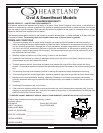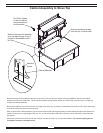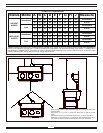
9
Installation
Be sure to read the sections on clearances, oor protection,
and chimneys before actively starting the installation. Contact
local building or re ofcials about restrictions and
installation in your area.
Clearances
A woodburning stove radiates heat in all directions. Heat
directed toward living areas in front of the stove is usually
very welcome.
However, heat radiating in other directions will not be as
welcome if it results in overheating nearby walls, ceilings
and oors.
An important part of planning a safe installation is to be sure
that combustible material located near your stove does not
overheat.
Clearance is the distance between your stove and stovepipe
and nearby walls, ceilings, and oors.
If there is adequate clearance, then the nearby surfaces will
not overheat.
The clearance distance should be empty except for non-
combustible heat shields.
(Continued on page 10)
Air owing between the stove and stovepipe and nearby
surfaces carries away heat.
Do not ll the empty space with any insulating material.
Be aware that as wood is exposed to continuous heat it dries
out, eventually lowering the temperature at which it will start
on re.
Maintain the clearances outlined in this manual, particularly
with respect to nearby combustible surfaces.
Your Heartland cookstove has been tested for safe operation
providing that these guidelines are followed.
Clearances must be maintained to all
combustible material. These include
doors, trim, furniture, drapes, newspapers
and clothes.
An optional heat shield kit is available for our woodstoves
for reduced clearances. See page 14 on “Heat Shield Kit”


















